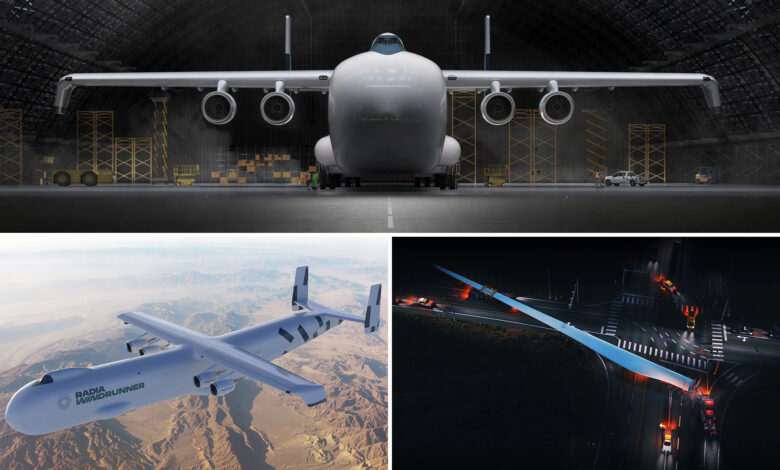It’s the Skytanic! Plans revealed for world’s largest plane — it’s a whopping 356 feet long

Call it the Skytanic.
Engineers have unveiled plans for the world’s largest airplane, dubbed the WindRunner, which could revolutionize renewable energy by transporting gigantic wind turbine blades from point A to B.
Designed by the Colorado-based energy company Radia, the behemoth cargo carrier measures a whopping 356 feet long and 79 feet tall with a wingspan of 261 feet.
For reference, this castle in the sky is nearly as long as a regulation NFL football field and 106 feet longer than the Boeing 747-8– the world’s longest passenger plane.
With a potential carrying capacity of 80 tons, it will also be able to hold 12 times as much the latter aircraft
In order to accommodate the jumbo jet’s landing, a 6,000 foot runway will also need to be constructed.
The WindRunner’s purpose is to fly the blades of onshore wind turbines — which measure between 150-300 plus feet long and can weigh 35 tons — to various wind farms.
Due to their gargantuan size and unwieldiness, these freakishly big fan blades currently have to be transported offshore via specialized marine vessels, which limit their use on land.
“Today’s largest wind turbines and the even larger ones of the future cannot be transported to prime onshore wind farms via ground infrastructure,” Radia writes on its website.
This challenge initially inspired Radia employees to undertake this massive endeavor.
“That was a very clear moment when the industry speaks to you,” Mark Lundstrom, the MIT-trained rocket scientist who founded the firm, told the Wall Street Journal while discussing how he first learnied about the limitations.
He spent the last seven years perfecting the design with an engineering team to ensure the WindRunner didn’t come apart when the rubber hit the runway.
In addition to carrying preexisting windmill whirrers, the WindRunner’s capacity would also pave the way for the development of even larger terrestrial turbines, which would be capable of generating even more power.
In fact, experts estimate that the larger air carvers could increase the consistency of power generation by 20% compared to the terrestrial turbines of today. They could also scale back energy costs by as much up to 35%.
This is an important development considering that wind accounted for 10% of the large-scale electricity generation in the US in 2022.
After keeping the WindRunner a secret for years, Radia claims these behemoth blade-runners could become a reality in just four years.
Along with revolutionizing the wind power sector, Lundstrom also believes his plane’s massive cargo capacity could have other applications, transporting massive military machinery.
The news comes as financial headwinds plague the offshore wind power industry. Last year, projects blew apart in in Rhode Island, Connecticut and Massachusetts, while Danish wind-power giant Ørsted torpedoed plans for two wind farms off the coast of New Jersey.
These wind woes have been attributed inflation, higher interest rates that drive up capital costs and severe kinks in the supply chain.
These same problems are slamming proposed offshore-wind projects in New York as developers make final decisions on whether to start building turbines or cut their losses before they get worse.




